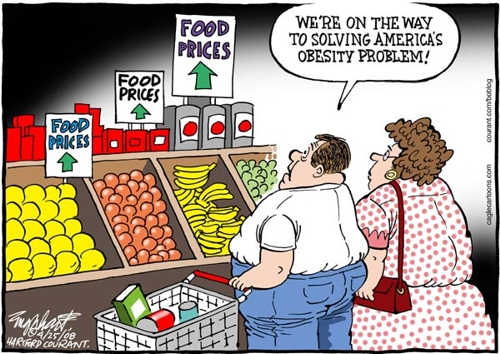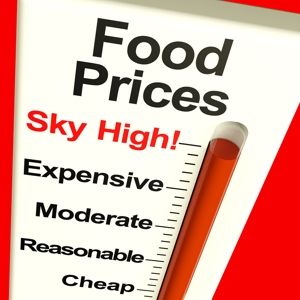It should come as no surprise – since nothing has changed, or is likely to change soon in the food supply chain or COVID situations – that food prices are forecast to rise sharply again in 2022. We hadn’t even gotten over how much more we were paying for food this year before the bad news landed in our laps…
 Dark humour, to be sure. But it’s the most-positive comment
Dark humour, to be sure. But it’s the most-positive comment
on the soaring-food-prices situation we’ve yet found…
It wasn’t long ago that I posted an update on rising food prices. The official Dalhousie University Agrifood Analytics Lab’s Canada’s Food Price Report for 2021 revealed that the average Canadian family of 4 paid almost $700 more for food in 2021 than it did in 2020. Now, the Lab has released its predictions for next year, and the news is once again bad.
The opening paragraph of the new report’s official news release lays it out in stark terms: “Canada’s Food Price Report 2022 forecasts an overall food price increase of 5% to 7% for the coming year, the highest predicted increase in food prices since the inception of the report twelve years ago. The most significant increases are predicted for dairy and restaurants at 6% to 8%, and bakery and vegetables at 5% to 7%.”
In real dollar terms, that means the family of 4 can expect to spend almost $1,000 more for food next year.
‘Should’ or ‘can expect to’ pay for food?
“It’s important for consumers to understand that food prices have been going up for some time, and there’s no turning back,” says Dr. Sylvain Charlebois, project lead and Director of the Agri-Food Analytics Lab. “Our relationship with food is changing, and so will our food budgets. Showing up at the grocery store knowing what you should be paying will help.”
I take exception to Charlebois’ use of the term, ‘should’ in the preceding sentence. I would have said, “Showing up at the grocery store being aware of what you can expect to pay will help.” The concept of ‘what we should be paying’ has all sorts of negative connotations. Perhaps, for me, it’s the similarity to the statement by the prime minister of the day, back when western oil sands development was just getting started, that “Canadians should be paying the world price for oil.” Nonsense. The dark intent behind that notion was to give the oil companies a huge windfall from domestic revenues, to fund the oil sands.
Anyway, what we ‘should’ be paying for food is a whole different issue than the one I believe Charlebois intended to address. But that’s fuel for another fire. And, to be fair, we should probably cut Charlebois a little slack; he’s an economist, not an English professor…
Causes and effects
We’re told a number of factors will drive up the cost of food in 2022: “Canada’s Food Price Report 2022 focuses on COVID-19-related disruptions to the food supply chain, climate change and adverse weather effects, labour force challenges, high inflation, and food transportation challenges.”
I think we’re all aware that ‘transportation challenges’ are largely a result of ‘labour force challenges’, and high inflation is largely attributable to resulting food product shortages that are driving prices up. It’s a self-perpetuating upward spiral fueled by consumer dollars. The circle must be broken to fix the system. The place to break it is at the ‘labor forve challenges’. Dock workers, truck drivers and warehouse workers have to get vaccinated and get back on the job, in spite of the persistent self-renewal of the COVID menace via new, virulent variants. But if that was going to happen (without some sort of official intervention), it would have happened by now. Human nature, superstition, and distrust of authority once again stand in the way of the solution to a major socio-economic problem.
And let’s not forget that the issues elucidated above are not just affecting Canada. The U.S. and Mexico, by close geographic and economic association, are similarly affected. The UK and Europe are not immune, either.
How much more can we afford?
More to the point, how much more can we stand? High food prices are already changing the way a majority of Canadians shop for groceries, and what they buy, according to a new report from the same Agri-Food Analytics Lab as the 2022 Food Price report. And that’s apparently just the beginning.
You may recall, in that post just this past October, Chicken and Pork prices had increased as much as 10 percent in the preceding 12 months, and cured meats were sky-high, increasing up to 20 percent. At that time, economists said prices should peak by the end of the year and start coming down again by next summer. But then, along came the Omicron variant, and the fight against COVID took a few more steps backwards. It’s anybody’s guess when inflation will moderate, and food prices will level off or decline again, now. And who knows how many more COVID variants we’ll see before that ‘challenge’ is finally met?
~ Maggie J.

